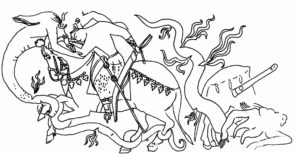Matteo Compareti
School of History and Civilization
Shaanxi Normal University
Since its discovery in the 1950s, the so-called “Blue Hall” at Panjikent has been considered a masterpiece of Sogdian art. Its paintings include a continuous program developing along the four walls, dedicated mainly to the great eastern Iranian hero Rustam, who is immediately recognizable by his leopard skin garments (Marshak 2002; Grenet 2015).
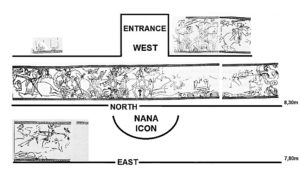
Fig. 1. Schematic reproduction of the Rustam painted program in the Blue Hall at Panjikent, sector VI/room 41 (ca. 740).
After: Marshak 2002, fig. 14, 16-17.
Rustam is always represented atop his reddish horse Rakhsh while fighting demons or moving into mysterious lands populated by strange creatures, as described in the Shahnameh by Firdousi. The painted program of Rustam is fairly well preserved on three walls, and seven scenes of the sequence can still be observed clearly [Fig. 1]. Cleaning by the Hermitage restorers of fragmentary parts of the Blue Hall, which are still unpublished, revealed at least two more scenes, including one in which the hero is received at court by the king and another that depicts a fight scene near a giant yellow bird, possibly a simurgh.
On an archaeological basis, the Rustam painted program should be dated to around 740 C.E. Although the paintings contain Sogdian inscriptions of epigraphical importance, their content does not refer to the scenes represented there. The first, a formulaic inscription, is addressed to the king, while the second is a writing exercise, most likely left by a student from a nearby school in an attempt to vandalize the painted room during a visit (Lurje 2014).
One scene is a representation of Rustam fighting with a snake demon that does not appear in the Shahnameh [Fig. 2]. There is a missing frame in the sequence, since the left portion depicts Rustam about to be swallowed by the monster while the right portion shows him moving forward, with the human snake lying on the ground already dead. Pavel Lurje has suggested that the missing frame should have depicted the killing of the monster from inside of its belly—the weapon Rustam holds in his right hand behind his back in the first part of the sequence would have been used to cut open the monster’s belly (Lurje 2014).
The story of a hero swallowed by a monster, usually a giant sea creature or dragon, represents a very well-known topos in world mythology: it can be found in ancient Greece, the Hebrew Bible, and also in the Christian world (Angelini 2010; Kuehn 2014; Miller 2018).
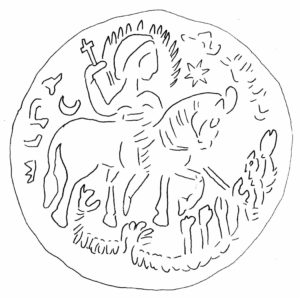
Fig. 3. Sasanian seal kept in the British Museum (acc. no. 119387). After: Harper 2006, fig. 96. Sketch by Matteo Compareti.
Representations of a hero fighting with a dragon can be found sometimes in pre-Islamic Persian art (Magistro 2000). Sasanian seals embellished with the scene of a haloed mounted knight fighting with a multi-headed giant snake, which could resemble the Hydra of Herakles’ trials, appear sometimes in museums and private collections [Fig. 3]. In at least one example, the man fighting the multi-headed snake is not on a horse (Ritter 2010: pl. X, A2019). During some recent excavations at Panjikent, the Russo-Tajik team also found a seal with the same scene of an armoured horse rider adorned with a helmet killing a snake monster. The scene is accompanied by the Sogdian inscription qaghan (Kurbanov et al. 2017: 11). A late 8th to early 9th century burnt wooden frieze, found at Shahristan (Ustrushana or eastern Sogdiana) in the shape of a semi-circular tympanum and originally installed above the entrance of an important room (possibly the throne hall), also presents seventeen decorative roundels containing fighting scenes. At least two of these scenes include a mounted warrior fighting a snake dragon (Bubnova 2016: 176).1 Though these kinds of images present some similarities with the scene in the Blue Hall at Panjikent, they are not exactly the same. In fact, the Sasanian and Sogdian monsters do not include any human body parts. Moreover, the entire scene looks more like an icon of Saint George, with clear allusions to the fight of good against evil, and figured, as usual, in the shape of a Biblical tempter (Rempel’ 1987: 136; Kuehn 2014).
As was mentioned some time ago by Boris Marshak (2002: 40), the monster in the Sogdian painting is a female one. This fact is evident in her long hair and pointed breasts. Legends and stories including women connected with monstrous snakes call to mind the three Gorgons of Greek mythology and especially Medusa, the only one of the triad who was mortal. Reflections of the story of Medusa can also be found in Islamic Persia and Central Asia (Compareti 2018). A large number of representations of monstrous snakes or dragons can be found in Islamic book illustrations. Among the most famous stories involving dragon-slaying heroes preserved in Firdousi’s Shahnameh, one could also mention the stories of Zahak; Feridun transformed into a dragon to test his sons’ courage; Ardashir pouring molten metal into the mouth of a giant worm; and the dragons killed by Gushtasp, Bahram Gur, and others. Curiously enough, under further examination, the third trial of Isfandyar, as described in the Shahnameh, represents a possible parallel with the scene depicted at Panjikent. In that story, Isfandyar is swallowed by a dragon but is able to defeat the monster by cutting its belly open from inside. L.I. Rempel’ (1986: 136) has already noted this curious similarity between the two Iranian dragon slayers, and G. Azarpay (1981: 96-97) considered that dragon fighter as not connected to any specific hero. In the painting of the Blue Hall at Panjikent, however, the hero wears panther skin garments typical of Rustam—not of Isfandyar, his fiercest enemy.
These stories were fairly popular in Islamic book illustrations. Illustrated copies of the Shahnameh even include embellished images of Rustam and Rakhsh fighting a dragon. One of the oldest illustrations of this specific episode can be found in a manuscript preserved in the State Public Library of St. Peterburg (ex Dorn, 329, cf. Adamova and Gjuzal’jan 1985: pl. 9). Pre-Islamic representations of snake monsters can also be found in Sogdian paintings. For example, a haloed person wearing a crown with snakes on his shoulders, possibly identified with Zahak, appears in one 6th-century Sogdian painting located on the northwestern corner of the portico of the principal hall of Temple I at Panjikent (Belenitskii and Marshak 1981: 68-69; Mode 1987). These dragons, however, do not evince any significant anthropomorphism or feminine aspects.
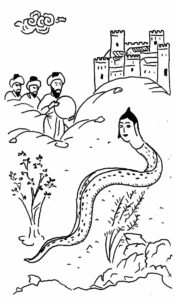
Fig. 4. Turkish manuscript kept in the Pierpont Morgan Library, New York ca. 1582 (suppl. turque 242, fol. 90v). After: Schmitz 1997, 83, fig. 120. Sketch by Matteo Compareti.
There are at least two Turkish book illustrations that reproduce a hybrid human-headed snake who looks into a mirror held by a man standing in front of him. One of them [Fig. 4] is dated ca. 1582 (suppl. turque 242, fol. 90v) and is at present kept in the Pierpont Morgan Library in New York (Carboni 1988a: 108-10, pl. 8; Schmitz 1997: 83, fig. 120). The second illustration [Fig. 5] (M.788, fol. 89v) is dated to the same period and is kept in the Bibliothèque National de France in Paris (Stchoukine 1966: pl. 46). In both miniatures, Medusa is evoked by a giant snake, whose head, adorned with long hair, could be that of a woman. In the upper part of both illustrations there is also a label identifying them as “the laughing snake and the mirror” (Shekl-i mar-i qahqaha va ayne). It is worth observing that, at least in the Turkish miniature kept in the Pierpont Morgan Library, the human head of the giant snake is smiling. Despite the lack of textual explications, the “laughing snake” could be associated with Zahak, another (male) serpentine heckler or mocker in Iranian legends who was rooted in more ancient Indo-Iranian myths (Schwartz 2012). The female creature in the book illustrations preserves all her negative traits. In fact, the walled city in the background suggests that her very presence constitutes a threaten to humans. For this reason, one man emerges from the group of people, bringing with him a mirror to prevent her assault. The expectation is that the human-headed snake will die or run away after looking into the mirror, since recognition of her own image will cause her to laugh herself to death. In addition, the idea of killing another being with its own reflected gaze presents some connections with serpentine monsters such as Medusa. It also emerges later, however, in Islamic book illustrations that may possibly be rooted in more ancient Indo-Iranian myths (Compareti 2018).
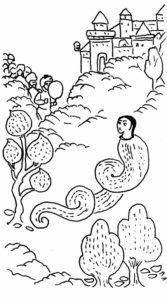
Fig. 5. Turkish manuscript kept in the Bibliothèque National de France, Paris ca. 1582 (M.788, fol. 89v). After: Stchoukine 1966, pl. 46. Sketch by Matteo Compareti.
Despite the lack of human arms in the Islamic book illustrations noted above, the images of snake women in Ottoman miniatures represent the only parallel with those Sogdian paintings in the Blue Hall that might demonstrate the presence of female snake-demons in the Iranian milieu at the dawn of the Arab invasion. It is not entirely clear if this section of the Sogdian paintings at Panjikent is connected to the story of Medusa; after all, Rustam does not hold a mirror in his hands. However, at least from an iconographical point of view, the Sogdian monsters and the human snake from the rare Islamic book illustrations could be considered female and thus very similar.
Creatures with deadly gazes are well known in Islamic literature and are not necessarily connected with snakes. Birds are also depicted with similar peculiarities, and may be considered to be another reflection of Medusa’s offspring. One page of the early fifteenth-century “Book of Wonders” (Kitāb al-bulhān) (Bodleian Library, Oxford, MS. Bodl. Or. 133), also includes a “Discussion on the Mountain of Fire and Salamander-Birds” (Al qawl ‘ala jabal al-nar wa tayr samandar) (Carboni 1988b: fol. 42v). Though the birds mentioned in the text do not evince fantastic peculiarities, it is clear that they can survive on the mountain of fire exactly like the Phoenix (‘Anqa). For this reason, they might have been confused with the salamander (samandar), an animal commonly associated with the igneous element in the ancient world. Some Turco-Iranian legends include the story of a hero who is transported by the Simurgh to the land of the “mountains of fire.” In order to pass through the fire without burning, the hero had to cover his body with the fat of the samandar, which is described as a winged horse (Melikoff 1962, 39). G. Scarcia collected some eastern Iranian legends about odd creatures that killed people and animals just by looking at them. These creatures could even kill themselves just by looking at their image in a mirror and laughing themselves to death (Scarcia 2003: 20).
One Islamic legend tells the story of the Prophet Muhammad, who saw a pillow belonging to his wife decorated with winged horses. The sight of this decoration caused Muhammad to break into hysterical laughter until he nearly died (Noja 1983). This seems to be a re-reading of the myth of Medusa, who gave birth to Pegasus from her beheaded neck. Even if it is not expressly stated as such in any written source, it is highly probable that the Greek Medusa not only petrified people, but also provoked in them such a strong laughter, prompted by sight of her hideous face, so as to cause their death (Vernant 1985 [2014]: 40-41). Hence the Islamic Pegasus is both renamed as samandar—i.e., Phoenix—and superimposes its own image onto the functions of the Simurgh from Turco-Iranian legends.
In the twelfth-century mystical treatise “The Red Intellect” (‘Aql-i sorkh) by Shihāb al-Din Sohravardi, there is an interesting description of the famous battle between Rustam, the eastern Iranian heroic defender of tradition, and Isfandyar, the champion of Zoroastrianism. According to this story, Rustam’s father, Zal, knew that anyone who looked at the reflection of the Simurgh in a mirror would be dazed. For this reason, he had the armour and helmet of his son thoroughly polished. Zal then made sure that the Simurgh cast his reflection upon Rustam’s armour. As expected, during the battle, the reflection of the Simurgh on Rustam’s armour dazed Isfandyar, who, thinking he was wounded in the eyes, subsequently died (Yarshater 1998: 588).
This episode does not appear either in Islamic book illustrations nor in the earlier representation of Rustam’s trials from the mid-eighth century Sogdian painted program in Panjikent. However, if the Simurgh is identified with the Phoenix, and the Phoenix can be confused with the salamander and Pegasus in the Islamic world, then it seems quite obvious that all these legends deal with Medusa’s deadly gaze—and that this deadly gaze was eventually transmitted to her equine son. In the Turkish illustrations examined above, the only part of the human body that is preserved is the long-haired head, with the rest of the body subsumed into serpentine form. Might it be possible, however, to consider the Islamic renderings of the Gorgon as connected to the story of Rustam at Panjikent?
Despite the fact that the story of Rustam and Medusa share interesting points of overlap, many of which survive in both Islamic texts and visual arts, they also exhibit certain differences with the Blue Hall scene at Panjikent. One of the first objections would be grounded in the story reported in “The Red Intellect.” Zal, a sorcerer, along with his son Rustam, are both described as allies of the Simurgh, thus evincing some common traits with Medusa and Pegasus (who is also conflated with the Phoenix and salamander). Moreover, the story of Medusa does not refer to her as a devouring monster, and her connection to snakes could be considered just a pretext to stress her monstrous nature.
As a result, Pavel Lurje (2014) has drawn upon Tajik folklore to propose a different reading of the story of Rustam fighting a female snake demon, as depicted in the Panjikent paintings. He shows that there is in fact at least one Tajik fable about a snake demon who was the mother of monstrous offspring. In this fable, all of the offspring would eventually devour people. In other words, the reason why the Sogdian paintings seem to be independent from the Persian text is likely because they were following eastern Iranian traditions of which Firdousi was either unaware or ignored. Sogdian texts from China include descriptions of epic heroes and other figures from the legend of Rustam. The longer episode, which survives in a fragment from the British Library, does not appear in the story included in the Shahnameh (Sims-Williams 1976; Sims-Williams 2004).2
Sogdian paintings from Panjikent also include the very first representation of Rustam, but not yet in his “canonical” form, which would be adopted some centuries later by Firdousi. Though Rustam’s name—literally “strong as a river”—should be considered western Iranian in origin (Sims-Williams 2004; Compareti 2016a: 26), Rustam himself was an eastern Iranian hero from Zabulistan whose stories and legends were well known in Central Asia before the Islamic era. Variations of Rustam’s story, which were incorporated into the Shahnameh, are to be expected among the Sogdians, whose literature and figurative arts probably preserved aspects of local traditions now found only in Tajik fables.
From an iconographical point of view, the snake demon at Panjikent does not present any clear parallel with illustrations of the trials of Rustam or Isfandyar, as are sometimes included in Shahnameh manuscripts. In fact, when those heroes are represented as fighting with snake dragons in Islamic book illustrations, the iconography of the monster is always the Chinese long 龍, a serpent-like creature imprecisely rendered as “dragon” in Western literature. As is well known, Chinese iconographical traditions established during the Song period (960-1279) were introduced into Persia at the time of the Mongol conquest under the Ilkhanids (1256-1353). These Song artistic traditions were used to represent not only fantastic creatures of the Iranian mythological canon, but also those of natural elements such as mountains, trees, and clouds (Vogelsang 2013). Chinese stylistic features were also incorporated into depictions of other creatures. In the case of the Simurgh, which is usually (and imprecisely) rendered as “phoenix” (Compareti, 2016a), the external iconography was modeled on the Chinese fenghuang 鳳凰.
However, a small group of Persian miniatures, mainly dated to the early fourteenth century, still presents an image of the Simurgh that appears to be based not on Chinese prototypes, but rather on an image of an owl included in one of the Panjikent paintings (Compareti 2016b: fig. 21). We thus cannot rule out the possibility that the paintings of the Blue Hall at Panjikent might still constitute a kind of “genuine Iranian prototype” not only for the Simurgh, but also for the image of the “Iranian dragon” as well. Such a hypothesis can not be substantiated, for the simple reason that there are no Islamic book illustrations for the dragon as there are for the Simurgh. From the Mongol period onward, nearly all dragons that have been represented in book illustrations are adaptations of the Chinese long, with the exception of the two Turkish miniatures noted above.
In any case, such considerations do not completely explain the female nature of the monster at Panjikent. It is possible that some elements were derived from stories of a monster connected with Medusa, which were very popular in eastern Iranian lands. Tajik fables mentioned by Lurje also resonate with similar well-known stories from ancient Greece, in which a monster associated with snakes bore responsibility for the death of newborn children. As is well known, the figure of Medusa was connected with Baubo (a personification of female sex), who appears in the myth of Demeter, as well as other creatures such as the ogress Lamia (Mesopotamian Lamashtu) and the chthonian goddess Hecate, who was known as a kidnapper of children (Childs 2003: 65; Ogden 2013: 95). All of these creatures also seem to be connected with the snake-women depicted in the Turkish illustrations mentioned above. In fact, it is highly probable that the monster was intended to represent a menace to the inhabitants of the walled city in the background. This menace was embodied in one of two ways: either by looking at them, or, possibly, devouring them—as snakes usually do.
Apart from the image of the female snake dragon, there seems to be at Panjikent some confusion regarding the main character of the story. Is it Rustam or Isfandyar? As noted above, in the Shahnameh it is Isfandyar who is swallowed by the dragon. In the Panjikent paintings, however, the dragon-fighting hero wears the leopard skin garments typical of Rustam. As is well known, one feature of the Isfandyar trials is the killing of the Simurgh. Curiously enough, at a certain point in the narration of the Shahnameh, Rustam also shoots the Simurgh with an arrow after the magic bird exhibits an aggressive posture. Even though this episode might be considered “marginal” (During 1988-89: 34), it is still included in the story of Rustam and represents a further convergence of the characteristics of Rustam with those of Isfandyar. Just like the Shahnameh narrative, the trials of Rustam as depicted in the Panjikent murals include several incongruous details. The story of Isfandyar, too, exhibits some inconsistencies. The death of the Simurgh, which will later prompt Rustam to prepare a magic arrow to be shot in the eyes of Isfandyar, is narrated, illogically, in a previous part of the Shahnameh. For this reason, popular traditions of this story seem to have invented a couple of Simurghs: one female and one male. The reason why the male Simurgh helped Rustam in his duel can be found in this version of the story, since the female Simurgh just wanted to avenge the death of her “husband” (Yarshater 1998: 588).
In a section of the Rustam program that has been recently restored in the State Hermitage, one can recognize a duel between the hero, adorned in leopard skin, and an opponent whose shoulders exhibit vivid flames (Compareti 2016b: fig. 9). This is a common way to represent an important character in Sogdian art. In this scene, the leopard skin-adorned hero uses a bow that in other parts of the painted program is portrayed as still in its case. As a result, it seems clear that this scene represents a depiction of the duel between Rustam and Isfandyar. In front of the hero identified with Rustam, there is a conventional flying composite creature associated with a commentary on his fortune (farn in Sogdian), while behind him there is an owl that is evocative of the small group of Islamic book illustrations that reproduce the Simurgh. At this point, every piece of the composition seems to find its proper place: the duel among two heroes who greatly resemble each other and are often sometimes mistaken for one another; a composite flying creature swooping in front of that hero who is destined to win; the body of the defeated hero trampled under horses with a broken round shield; and the Simurgh appearing behind the victorious warrior (Fig. 1 above, bottom left).
Those Sogdian paintings raise many questions about Iranian traditions, which we might regard as the literary foundation of the Shahnameh itself (with or without illustrations). It seems plausible to conclude that it was in Sogdiana rather than in Persia where many pre-Islamic Iranian traditions were preserved. Images such as those depicted in the Sogdian paintings at Panjikent did not appear in pre-Islamic Persian art because the Sasanians identified more with Isfandyar, the champion of Zoroastrianism, than they did with Rustam, who was treated as a heretic (Browne 1900: 206-11). Only several centuries later was Rustam accepted in Islamic Persia as a proper Iranian hero; or, in his case, as an “Iranized prophet,” just as another antagonist of Zoroastrian literature—Alexander the Great—was treated before him.
About the Author
Matteo Compareti currently teaches the history of pre-Islamic Central Asian art at Shaanxi Normal University in Xi’an, China. Previously he was Guitty Azarpay Distinguished Visiting Professor at the University of California, Berkeley. His research interests include the iconography of so-called Zoroastrian deities in Sasanian art and pre-Islamic Sogdian paintings. He has published in Italian, English, and Chinese. Among his more recent publications are Samarkand the Center of the World: Proposals for the Indentification of the Afrāsyāb Paintings (Mazda: Costa Mesa, 2016) and “The Late Sasanian Figurative Capitals at Taq-i Bustan: Proposals Regarding Identification and Origins,” in Yuka Kadoi, ed., Persian Art: Image-Making in Eurasia (Edinburgh: Edinburgh University Press, 2018): 20-36. E-mail: <compareti@hotmail.com>.
References
Adamova and Gjuzal’jan 1985
Adel’ T. Adamova and Leon T. Gjuzal’jan. Miniatjury rukopisi poemy “Shahname” 1333 goda [Miniatures of the manuscript poem “Shahname” from year 1333]. Leningrad: Iskusstvo, 1985.
Angelini 2010
Anna Angelini. “Inghiottiti e inghiottitori: di alcuni mostri del mito antico” [Swallowed ones and swallowers: on some monsters of ancient myth]. In: Simone Beta and Francesca Marzari, eds., Zoomania. Animali, ibridi, mostri nelle culture umane, Firenze: Cadmo, 2010: 237-64.
Azarpay 1981
Guitty Azarpay. Sogdian Painting: The Pictorial Epic in Oriental Art. Berkeley: University of California Press, 1981.
Belenitskii and Marshak 1981
Aleksandr M. Belenitskii and Boris I. Marshak. “The Paintings of Sogdiana.” In: Guitty Azarpay, ed., Sogdian Painting: The Pictorial Epic in Oriental Art. Berkeley, Los Angeles, London: University of California Press, 1981: 11-77.
Browne 1900
Edward G. Browne. “Some Account of the Arabic Work Entitled “Niháyau’l-irab fi akhbári’l-Furs wa’l-‘Arab,” Particularly of that Part which Treats of the Persian Kings.” Journal of the Royal Asiatic Society 32, no. 2 (1900): 195-259.
Bubnova 2016
Mirra Alekseevna Bubnova. “Early Medieval Ages.” In: Rahim Masov, Saidmurod Bobomulloev, and Mirra Bubnova, eds., National Museum of Antiquities of Tajikistan, Dushanbe, 2016: 139-85.
Carboni 1988a
Stefano Carboni. “Ricostruzione del ciclo pittorico del Kitāb al-bulhān di Oxford: le miniature delle copie ottomane mancanti nell’originale” [Reconstruction of the painted program of Kitāb al-bulhān in Oxford: the miniatures of the Ottoman copies which do not appear in the original text]. Annali di Ca’ Foscari 27, no. 3 (1988): 97-126.
Carboni 1988b
———. Il Kitāb al-bulhān di Oxford [The Kitāb al-bulhān of Oxford]. Torino: Editrice Tirrenia Stampatori, 1988.
Childs 2003
William A.P. Childs. “The Human Animal: The Near East and Greece.” In: J. Michael Padgett, ed., The Centaur’s Smile: The Human Animal in Early Greek Art, New Haven: Yale University Press, 2003: 49-70.
Compareti 2016a
Matteo Compareti. “Flying over Boundaries: Auspicious Birds in Sino-Sogdian Funerary Art.” In: Stefano Pellò, ed., Borders Itineraries on the Edges of Iran, Venezia, 2016: 119-53.
Compareti 2016b
———. “La raffigurazione della ‘gloria iranica’ nell’arte persiana e la sua distinzione dall’uccello fenice/simurgh” [The representation of the “Iranian Glory” in Persian art and its distinction from the phoenix/simurgh bird]. Archivi di Studi Indo-Mediterranei (2016), No. VI. Available online: http://kharabat.altervista.org/RSIM6_Compareti_Manifestazione_Goria.pdf
Compareti 2018
———. “Images of the Gorgon in Persian Tradition and Islamic Book Illustrations.” In: Matteo Compareti, ed., Fabulous Creatures and Spirits in Ancient Iranian Culture. Proceedings of a Workshop at the Near Eastern Department, University of California Berkeley, Bologna: Persiani Editore, 2018: 121-51.
During 1988-89
Jean During. “Le mythe du Simorgh dans la musique extatique du Baluchistan.” Luqmān V, no. 1 (1988-89): 21-38.
Grenet 2015
Frantz Grenet. “Between Written Texts, Oral Performances and Mural Paintings: Illustrated Scrolls in Pre-Islamic Central Asia.” In: Julia Rubanovich, ed., Orality and Textuality in the Iranian World. Patterns of Interaction across the Centuries, Leiden: Brill, 2015: 423-29.
Harper 2006
Prudence O. Harper. In Search of a Cultural Identity: Monuments and Artifacts of the Sasanian Near East, 3rd to 7th Century A.D. New York: Bibliotheca Persica, 2006.
Kuehn 2014
Sara Kuehn. “The Dragon Fighter: The Influence of Zoroastrian Ideas on Judaeo-Christian and Islamic Iconography.” ARAM Periodical 26, no. 1-2 (2014): 59-92.
Kurbanov et al. 2017
Sharof F. Kurbanov, Abdurahmon G. Pulatov, and Alexej G. Akulov. “Zavershenie rabot na ob’ekte XXVI” [Conclusive works in sector XXVI] In: Materialy Pendzhikentskoj arhelogicheskoj ekspedicii, XXI, Sankt-Peterburg: Gosudartvennyj Ermitazh, 2017: 5-15.
Lurje 2014
Pavel B. Lurje. “Ktolkovaniu syuzhetov i nadpisej pendzhikentskogo zala c Rustamom [Some comments about the subjects and inscriptions of the Rustam Room at Panjikent].” Trudy Gosudarstvennogo Ermitazha LXXII (2014): 95-102.
Magistro 2000
Maria Rita Magistro. “Alcuni aspetti della glittica sacro-magica sasanide: il ‘Cavaliere nimbato’” [Aspects of holy-magic Sasanian glyptic: the “haloed horseman”]. Studia Iranica 29, no. 2 (2000): 167-94.
Marshak 2002
Boris I. Marshak. Legends, Tales, and Fables in the Art of Sogdiana. New York: Bibliotheca Persica Press, 2002.
Melikoff 1962
Irene Melikoff. Abū Muslim. Le “porte-hache” du Khorassan dans la tradition épique turco–iranienne. Paris: Adrien Maisonneuve, 1962.
Miller 2018
Robert Miller. The Dragons in the Bible and Beyond. Winona Lake: Eisenbrauns, 2018.
Mode 1987
Markus Mode. “Die Gottheit mit den Drachenschultern (zur Herkun und Identität des “Ḍaḥḥāk” von Pendžikent).” Hallesche Beiträge zur Orientwissenschaft 11 (1987): 65-81.
Noja 1983
Sergio Noja. “Les chevaux ailés de ‘Ā‘išah – Dieu soit satisfait avec elle – et les banāt.” Annali dell’Istituto Orientale di Napoli 43, no. 1 (1983): 33-42.
Ogden 2013
Daniel Ogden. Drakōn. Dragon Myth and Serpent Cult in the Greek and Roman World. Oxford: Oxford University Press, 2013.
Rempel’ 1987
Lazar’ I. Rempel’. Cep’ vremeni. Vekovye obrazy i brodjachie syuzhety v tradicionnom iskusstve Srednej Azii [The chain of time. Secular images and wandering subjects in the artistic tradition of Central Asia]. Tashkent, 1987.
Ritter 2010
Nils C. Ritter. Die altorientalischen Traditionen der sasanidischen Glyptik. Form, Gebauch, Ikonographie. Wien-Berlin: Lit Verlag, 2010.
Scarcia 2003
Gianroberto Scarcia. “Sulla Fenice dei Baluci” [On the phoenix of Baluchistan]. In: Il falcone di Bistam. Intorno all’iranica Fenice/Samand: un progetto di sintesi per il volo del Pegaso iranico tra Ponto, Alessandretta e Insulindia, ed. Matteo Compareti and Gianroberto Scarcia, Venezia: Cafoscarina, 2003: 7-26.
Schmitz 1997
Barbara Schmitz. Islamic and Indian Manuscripts and Paintings in the Pierpont Morgan Library. New York: The Pierpont Morgan Library, 1997.
Schwartz 2012
Martin Schwartz. “Transformations of the Indo-Iranian Snake-Man: Myth, Languages, Ethnoarchaeology, and Iranian Identity.” Iranian Studies 45, no. 2 (2012): 275-79.
Sims-Williams 1976
Nicholas Sims-Williams. “The Sogdian Fragments of the British Library.” Indo Iranian Journal 18 (1976): 43-82.
Sims-Williams 2004
———. “Rustam Fragment.” In: Susan Whitfield and Ursula Sims-Williams, eds., The Silk Road: Trade, Travel, War and Faith, London: The British Library, 2004: 119.
Stchoukine 1966
Ivan Stchoukine. La peinture turque d’aprés les manuscrits illustrés. 1er partie de Sulaymān Ier à ‘Osmān II (1520–1622). Paris: Librairie Orientaliste Paul Geuthner, 1966.
Vernanat 2014
Jean-Pierre Vernant. La mort dans les yeux. Figures de l’autre en Grece ancienne. Paris: Hachette, 1985.
Vogelsang 2013
Willem J. Vogelsang. “Chinese Influence on Iranian Art in the Mongol Empire.” In: William W. Fitzhugh, Morris Rossabi, and William Honeychurch, eds., Genghis Khan and the Mongol Empire, Houston: The Metropolitan Museum of Art, 2013: 232-37.
Yarshater 1998
Ehsan Yarshater. “Esfandīār.” In: Ehsan Yarshater, ed., Encyclopaedia Iranica, vol. VIII, Costa Mesa CA, 1998: 584-92.
Yoshida 2013
Yutaka Yoshida. “Heroes of the Shahnama in a Turfan Sogdian Text: A Sogdian Fragment Found in the Lushun Otani Collection.” In: Pavel B. Lurje, Asan I. Torgoev, eds., Sogdians: Their Precursors, Contemporaries and Heirs, St. Petersburg: The State Hermitage Publishers, 2013: 201-18.
Endnotes
1 A description of this tympanum, accompanied by better images, was presented by Pavel Lurje at the “L’Ustrushana dans l’Antiquité et le haut Moyen Âge: des marges de l’œkoumène au cœur du pouvoir Abbasside” conference in Paris, May 18, 2018. A recording of Lurje’s paper, “Some Thoughts on Wooden Lunette from the Qahqaha Palace,” is available online: http://www.college-de-france.fr/site/frantz-grenet/symposium-2018-05-18-11h45.htm
2 Some other fragmentary Sogdian texts dealing with Rustam and the Simurgh are kept in Japan (Yoshida 2013).

